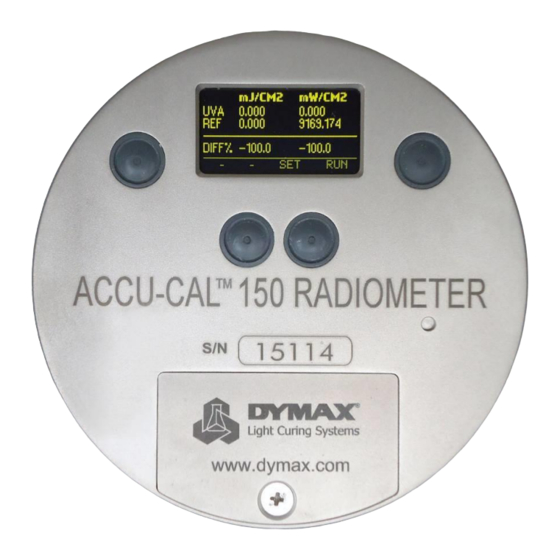dymax ACCU-CAL 150 Kullanıcı Kılavuzu - Sayfa 11
Ölçüm Cihazları dymax ACCU-CAL 150 için çevrimiçi göz atın veya pdf Kullanıcı Kılavuzu indirin. dymax ACCU-CAL 150 20 sayfaları. Uv radiometer

Display Window Cleaning Instructions
Use a soft cloth to clean the Display Window. Use of isopropyl alcohol is acceptable.
WARNING:
Do not use acetone to clean the Display Window. It may damage the Display Window.
Optics Window Cleaning Instructions
The following guidelines are for cleaning the optical surfaces on Dymax instruments. However, Dymax cannot
have full knowledge of contaminants present in all applications and as a result cannot test for their effects.
Therefore, we cannot assume responsibility for damage to customer instruments, which results from following
these directions once the warranty period has expired. Customers are advised to obtain and read the MSDS
for any chemical used for cleaning optics and for taking necessary precautions. Dymax makes no claim for the
safety of any of these chemicals.
STEP 1. LOOK
Closely examine the surface of the optics. If no contaminant is visible, it is best not to clean the instrument.
The optics are delicate and handling should be minimized. The two exceptions to this rule are when:
A process chemical has come in contact with the instrument's optics, or
A shift in readings has been observed with the instrument and the design of the UV light-curing system is
such that contamination of the radiometer is a possible cause of the measurement error.
STEP 2. BLOW
Use compressed gas to remove any loose material from the surface of the optics. This step is necessary
because loose material, especially silicates and other abrasive components can cause scratching of the optics
during the remaining steps. Compressed gasses we recommend, in order of preference, are:
Dry nitrogen
®
Chemtronics
Duster (PN ES1017, ES1217, ES1617) or similar tetrafluoroethane-based products
A rubber air bulb (typically found in camera supply shops)
Compressed air from an oil-free, instrument-grade system, sometimes referred to as instrument air
In the case of any compressed gas, it is best to avoid making the Optic too cold. The resulting condensation,
while typically easy to remove, presents added difficulty in the cleaning process.
NOTE: Blowing on the optics with the mouth is not recommended. Various components of saliva are
extremely difficult to remove from the optics. Using ordinary compressed air (sometimes referred to as shop
air) should also be avoided because of the difficulty in removing oil from the optics.
STEP 3. FLOOD
Apply a liberal amount of solvent to the Optics Window. The purpose of the solvent is to loosen the
contaminants from the surface so surface tension can remove the contaminant in Step 4. The solvents used
depend on what the user has available and what contaminants are expected in the field. EIT Instrument
Markets recommends cleaning the optic once with isopropyl alcohol and once with acetone for best results.
Dymax ACCU-CAL™ 150 Radiometer User Guide
11
